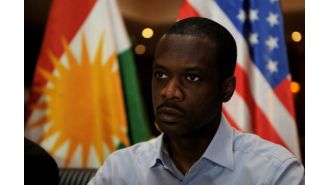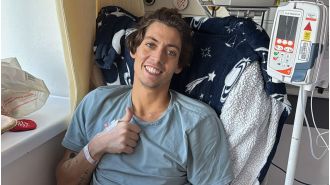The Met Will “More Thoroughly” Investigate Artwork Origins With Hire of Provenance Researchers
The museum announced this week that it will hire additional experts to look more deeply into the histories of works in its collections. The plans follow news reports and criminal investigations on the origins of some items.

Series: The Repatriation Project
The Delayed Return of Native Remains
The Metropolitan Museum of Art announced this week that it plans to hire four experts to investigate “more thoroughly” the history of works in its collections. The decision follows criminal investigations into some items in the museum’s collection, as well as news reports, including by ProPublica, that the museum has displayed items that were allegedly stolen or lacked provenance showing they were legally obtained.
As part of ProPublica’s Repatriation Project, the news organization researched every Native American work donated or loaned to the Met by the noted art collectors Charles and Valerie Diker. That reporting showed that only 15% of the 139 works provided by the Dikers had solid or complete ownership histories. Most either had no histories listed, identified previous owners in such vague terms as an “English gentleman,” or left gaps in ownership ranging from 200 to 2,000 years.
While it’s common for antiquities to have gaps in their documented histories, several art experts said the Diker Collection has an unusually large share of works with missing provenance, suggesting some of the pieces could be either fraudulent or stolen, the experts said.
For example, the provenance for an ancient Hopi (or Ancestral Pueblo) piece in the Diker Collection — a storage jar made between 1050 and 1100 — begins about 800 years after it was made, in 1984, when the Dikers bought it from a gallery in Scottsdale, Arizona. A researcher for the Hopi cultural office told ProPublica the jar was likely looted.
In a written statement to ProPublica before the prior story’s publication, the Dikers said that before acquiring the works they had assessed “all available information relating to provenance.”
As of April, the museum said it had accepted the transfer of 77 gifts from the Diker Collection.
In this week’s announcement, Met director Max Hollein acknowledged the work that the institution must do related to its Native American items. “The recent milestone of having greatly expanded our collection of Native American art substantially diversified our presentation of American art and dramatically broadened our outreach and ties to tribal communities,” he said.
Earlier this year, the Met said that it had drafted a new Native American Arts Initiative in 2021 under the guidance of its “first-ever” curator of Native American art, Patricia Marroquin Norby (Purépecha). The initiative includes “creating an advisory committee and hiring a full-time staff position that will collaboratively focus on NAGPRA responsibilities and further prioritize the building of ongoing partnerships as well as the strengthening of community collaborations,” the Met said. In March, the museum said it was also hiring a Native American art researcher whose duties would include “some provenance research.”
The Met did not respond to requests for comment this week. But in response to ProPublica’s earlier reporting on the Diker Collection, the museum said in a statement, “Although some progress has been made in updating the online catalog information and providing more complete provenance information, we recognize there is still much work to do and that this is an ongoing process that requires relationship building, patience, and great care. This is important work, and it is precisely one of the intentions of the Dikers to have a large, well-resourced institution such as The Met devote the time and scholarship to these Native items.”
The Native American Graves Protection and Repatriation Act of 1990, or NAGPRA, says that a museum receiving federal funds must alert tribal representatives no later than six months after it receives objects created by that tribe’s ancestors. However, ProPublica found that the Met had sometimes waited years before contacting tribes. The museum contacted some tribes only after ProPublica asked about the works in their collections. Since then, the Met has said it plans to return to the Dikers at least one loaned item, a quiver-and-arrow set made around 1875 by an “Apache artist.”
Dozens of Native American tribal officers told ProPublica that they had yet to hear from the museum about their tribes’ items in the Diker Collection.
Max Bear, the Tribal Historic Preservation Officer for the Cheyenne and Arapaho Tribes of Oklahoma, said that he has not heard from the Met in the eight years he’s worked as a tribal historic preservation officer and supervisor. “I know the Met has a lot of Cheyenne and Arapaho objects,” he said, including color drawings on ledger paper. “I’d like to work with them,” he added, and “get an opportunity to see the collection.”
Rosita Worl, president of Sealaska Heritage and a Tlingit citizen, was pleased to hear of the Met’s intention to hire more provenance researchers. “I think it’s a step in the right direction,” she said. “It’s good news, assuming that the Met will consult with the tribes.” Worl noted that when museum curators talk to ethnographic specialists and combine their findings with the knowledge of indigenous leaders, “there is a wealth of information that can be had.”
The Met’s announcement of the four new provenance hires mentioned foreign countries, including Egypt, Greece, India, Italy, Nepal, Nigeria and Turkey, whose works are in the museum. But it did not name any tribal nation.
In July, state and federal agents seized 21 allegedly stolen antiquities valued at more than $11 million, including a marble head of the Greek goddess Athena from 200 B.C., according to a search warrant ProPublica obtained. The International Consortium of Investigative Journalists reported in March that the Met had possessed more than 1,000 objects that were tied to people allegedly involved in crimes related to the antiquities trade. The Manhattan district attorney’s office has returned some of those confiscated works to foreign countries.
No one at the Met has been charged. But a museum donor, Michael Steinhardt, returned $70 million worth of stolen antiquities. He denied criminal wrongdoing but in 2021 agreed to a lifetime ban on acquiring antiquities to resolve a criminal investigation.
Hollein cautioned that the museum’s examination and decisions about its collections will take time.
“In some areas, we are able to make swift and definite moves, and in others it may literally take years to acquire the needed provenance information and even more time to collaborate with other museums, nations, or individuals to find the right solution,” he wrote. “Despite the urgency the media environment may suggest, we must be diligent, thoughtful, and fair in our evaluation of any evidence being presented to us. We are committed to getting it right, and equally committed to taking the time necessary to do so.”
Submit A Tip We take your privacy seriously, and we will contact you if we wish to publish any part of your story. We may not be able to respond to everyone, but we read each submission and they help inform our work.
If you can’t access our form, contact our reporters at [email protected] or (206) 419-7338.
ProPublica is a nonprofit newsroom that investigates abuses of power. Sign up to receive our biggest stories as soon as they’re published.
ProPublica is a nonprofit newsroom that investigates abuses of power. Sign up to receive our biggest stories as soon as they’re published.






